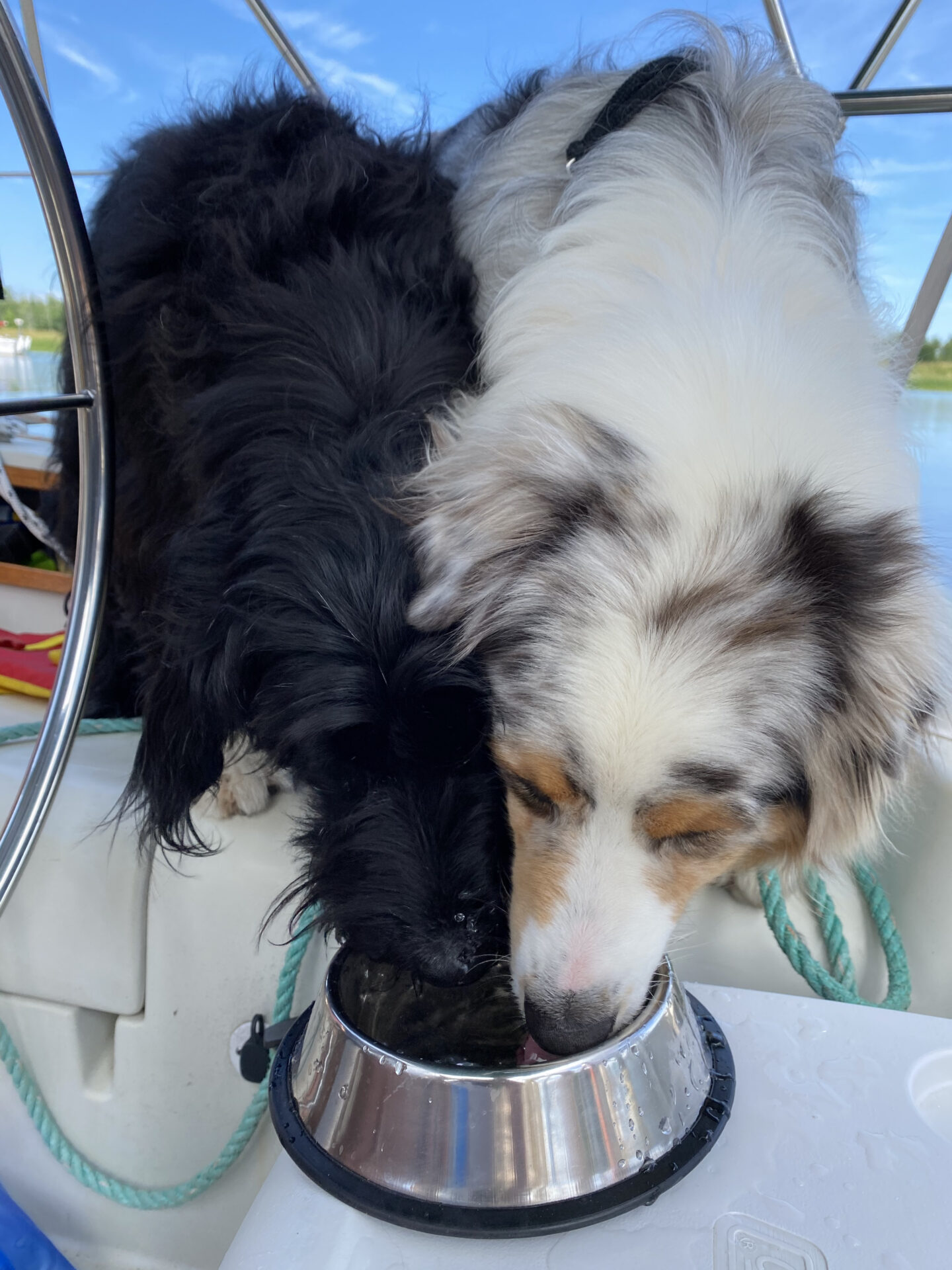The anchor snags tight and the engine shuts down. Scrambling clumsily into the cockpit, Cash, our 60-pound, three-year-old Australian shepherd, dances around while he waits for the buckles on his lifejacket to snap closed. With unbridled enthusiasm, he jumps down into the waiting dinghy. A warm breeze picks up the pungent scent of low tide and it tickles his nostrils. The chance to finally explore an undiscovered beach is here! Seashells to dig up, waves to run through and uncountable objects to mark!
The outboard strikes up and off we go, wind blowing his floppy ears back against his furry head. Sun’s out, tongues out—that’s his motto. Adventures await!
Those of us who share our boating lifestyle with furry family members know it adds a deeper gratitude for this pastime we all love. The phrase, “Wanna go to the boat?” gets most boat dogs up and running for the car. But while we want to bring our tagalong buddies—feline, canine or feathered—with us, it’s important to be prepared for the unexpected. Nobody anticipates an injury or illness before it happens, but it pays to be prepared in case it does. The more you travel, the more opportunities your pet has to encounter the unforeseen.
The most common visits at the 24-hour emergency veterinary clinic Dr. Caroline Ohse works at in Kelowna, British Columbia, are heat related injuries, allergic reactions, trauma and poisonings. But with a proper first aid kit, knowledge of how to use it and emergency veterinary contacts at hand, many minor illnesses may be treated onboard.
“You can do a lot with a simple first aid kit that’s going make the outcome for your pet more positive,” said Dr. Ohse. “And also going to ease the work for the veterinarian once you get there.”
Temperature Related Illnesses
While the average temperature of a West Coast summer is approximately 22°C, if this summer was any indication, that number is on the rise. Regardless, it can seem much warmer on the water. Dogs and cats are exposed to high temperatures on the boat with limited shade available, and can overheat quickly. Heat stroke can be a very serious condition, and if left untreated can become life threatening.
Provide pets with plenty of clean, fresh water and a cool place to rest, and watch for the signs of overheating. These include heavy or excessive panting, vomiting and drooling, agitation, diarrhea, tremors or collapse.
“If any clinical signs are noted, do not aggressively cool your pet,” cautioned Dr. Ohse. “Place your pet in a cool area away from direct sun exposure, provide air flow like cooling fans and place tepid cooling packs around the animal.”
If you don’t have cooling packs, use cold water bottles.
Boating in colder months runs the risk of another weather-related illness—hypothermia. If your pet is exposed to frigid waters or becomes cold and wet during winter boating, bring them into a warm, sheltered place to rest with dry bedding and fresh water. Towel dry them as best as possible, and watch for signs of hypothermia, including excessive shivering, lethargy, stiff muscles, pale gums and lack of coordination. They may also exhibit fixed and dilated pupils and low heart rate and breathing rate.
All of these cases should be seen by your veterinarian and assessed for body temperature and overall symptom severity including neurologic function.
Allergic Reactions
The second most common cases Dr. Ohse sees at her clinic involve allergies. Pets are susceptible to insect bites, wasp stings and contact allergens. An allergy to an insect bite or sting will present as swelling at the site, heat, hives, pain, itching or even nausea or diarrhea in more severe cases.
Dr. Ohse recommends that if your pet has a known allergy, carry the correct prescription medication from your veterinarian in your first aid kit. If you are concerned, call your veterinarian to confirm if an approved form of antihistamine, such as Benadryl, could be used.
“There are many formulations of diphenhydramine (antihistamine) and only certain forms are safe for pets,” added Dr. Ohse. “Check with your veterinarian beforehand to pick up the right prescription.”
While most allergic responses from an insect in pets are mild, if symptoms do not resolve on their own, you may need to call or visit your veterinarian.
Trauma
Karen and her husband David Richards remember the summer of 2020 well. Not because it was the first sailing season coping with COVID-19, but because it was the summer that they had to hastily pull anchor to rush their nine-year-old golden retriever in for emergency surgery.
The Richards live aboard their 40-foot Bayfield, Dakota, with their dog Charlie. Last summer they were exploring Desolation Sound Marine Park.
“We have a stocked first aid kit for [Charlie], which includes the various gauzes, self-sticking wrap, board to stabilize fractures and the various cleaning solutions,” said Karen.
Unfortunately, as well stocked as their first aid kit was, and even with emergency medical training, some more serious injuries require further medical help, as Karen and David were about to learn. During a shore walk, their 108-pound dog leapt onto a rock, and immediately started limping.
“Both Dave and myself are retired medical workers. He was a paramedic and I was an emergency room nurse, so we knew pretty much what was going on and what was going to happen,” she said. “He couldn’t walk so we used a rolled-up towel to get him in and out of the dinghy, [and] lifted him up and down into the boat and to assist him walking to go to shore.”
They scheduled an appointment with a clinic at Pender Harbour and set sail. There they diagnosed Charlie with a torn cranial cruciate ligament in his left knee and he would require surgery. They located an orthopaedic surgeon in Gibsons who managed to move other non-urgent surgeries around to accommodate Charlie.
After 12 weeks, Charlie was as good as new, and ready for his next adventure.
Most boating related traumas seen at Dr. Ohse’s clinic include minor cuts or torn nails, paw abrasions or punctures. In all of these cases, Ohse says having a well-stocked first aid kit on board is a priority in cleaning and bandaging the wound.
“If there is active bleeding, compress the wound with medical gauze or the next best item you have available,” said Ohse. “Apply a healthy amount of pressure for a minimum of one minute before reassessing.”
Take a closer look at the wound once bleeding has stopped. For superficial cuts, clean it with some rubbing alcohol and apply an antibiotic ointment. Cover the wound with a non-adhesive wound pad and cover with an elastic bandage. To ensure the bandage is not too tight, check that the area under the bandage is warm, and not swelling. As long as the bandage does not slip out of place, it is tight enough. Keep the bandage dry, and change the dressing once a day, or if it starts bleeding again.
If the wound is deep, or you are unable to stop the bleeding, call the nearest veterinarian clinic to arrange for a more thorough look.
Toxicity
Laurel Cooper, now 91 years young, reminisced about her time with her late husband Bill, cruising through the Greek Islands with their one-eyed cat, Nelson. In the 1980s, the co-authors of the bestselling book, Sell Up & Sail, travelled on board their self-built 55-foot ketch, Fare Well. For 11 of those years, Nelson sailed with them across many oceans.
On one occasion, Nelson developed some type of skin disease. They had recently met another liveaboard, a German man with some veterinary training. He asked if they had been feeding Nelson a lot of fresh fish and explained that he thought with a fish-heavy diet, Nelson had developed a case of “the mushrooms.” The fellow yachtie had 13 cats onboard(!), leading Laurel and Bill to believe he knew something about felines, so they switched to a dried cat food with vitamins in it, and the “mushrooms” went away.
While local knowledge can be important in helping to diagnose minor conditions and in collecting valuable information, Dr. Ohse recommends speaking with a veterinarian if you are unsure, or if the condition worsens.
Animals love to explore and eat the strange things they find on shore, and oftentimes the more odorous and unpleasant, the more enticing it is. But many toxicities occur onboard. The first rule in prevention is to ensure all human medications and foods that are toxic to animals (chocolate, raisins) are stored securely and are inaccessible to all pets. Keep mechanical fluids, chemical solutions and cleaning supplies safely stored away.
If you suspect your pet has consumed something, call your veterinarian, or poison control; Animal Poison Control Centre (ASPCA) 1-888-426-4435 or the Pet Poison Helpline at 1-800-213-6680 (fees apply).
“Depending on the type of poison, it may or may not be necessary to induce vomiting in your pet. Never induce vomiting unless you have been instructed to do so by your veterinarian or poison control personnel,” said Dr. Ohse.
In the case of a poisoning, the animal will require medical attention as soon as possible, but it is important not to panic. Gather together the type of poison ingested, chemical makeup, concentration, ingestion amount and time of ingestion. This information is prudent, added Dr. Ohse.
If you catch your pet eating a plant or mushroom, take a photo of it and email it to your vet to find out if it is safe, what symptoms to watch for or if you should head straight to the clinic.
Locate Clinics Before Leaving
Before heading out on any trip, a great deal of research is done to become familiar with any nautical hazards and to map out places of interest and secluded coves with good holding along the desired route. But just as important as the walking distance from mooring to museum is locating veterinary clinics along the route.
A quick Google search will find some clinics, but be sure to review the open hours and days, as some remote locations may have rotating veterinarians who move from clinic to clinic. Call a few to ensure the information online is up to date, and confirm that they will be open and note the best way to contact them if needed.
Enter the phone numbers and addresses into your phone in case you are in an area without service, or better yet, write it on a brightly coloured piece of paper and tape it in a visible location in your navigation station. When encountered with an emergency situation, it helps to have vital information right in front of you, so you don’t have to rummage through drawers.
If you have the technology, enter the coordinates into your chart plotter before you go.
Carry a copy or picture of your pet’s health records with you, and if your pet is on medication, bring extra in case your multi-day trip takes longer than planned.
Boaters are passionate about finding new remote anchorages, and the more out of the way they are, the harder it can be to find medical assistance for your pets when you need it. Having a well-stocked pet-specific first aid kit, and knowing how to use what is in it, will give you some peace of mind.
There is no better way to foster the animal-human bond than bringing our four-legged furry friends on our watery adventures. And if boating has taught me anything, it’s always best to plan for the worst, and hope for the best.
I get such joy from watching my own two pampered pooches relax on the cabin top in the warm sun, occasionally lifting their heavy heads to sniff the breeze and say hello to other passing pets on board. And with all of the animals we see on our voyages, I know I am not alone.
Happy tails and happy trails!
Introducing pets to the Boat
Not all pets take to the boating lifestyle easily. The loud engine and other unfamiliar noises, the rocking of the boat, and large objects moving overhead, like the sails, can cause anxiety. Dr. Caroline Ohse recommends the following tips to introduce your pet to the boat and help the transition afloat go smoothly:
- Ensure your pet has, and wears, a well-fitted lifejacket.
- Before bringing your pet to the boat, build their confidence in and around water by frequent visits to a beach.
- Preferably, bring your pet to the boat when it is on the hard for short visits so they can get used to it without it rocking around. If the boat is launched, do some short, frequent trips to the boat without leaving the dock.
- Provide lots of positive reinforcement (treats, toys).
- Once the pet shows confidence on the boat, keep the first few outings short and build from there depending on your pet’s stress levels and comfort. Bring along comfort items like toys and blankets to make your pet feel secure and safe.
- If you already have a pet who is confident on the boat, this can help the new or anxious pet learn the ropes.
Create a First Aid Kit for your Pet
– From the Canadian Veterinary Medical Association
- Muzzle
- Protective gloves
- Digital/rectal thermometer (note: a fever in a dog or cat is considered anything over 39.5°C)
- Rubbing alcohol
- Lubricating jelly
- Pen light
- Blanket for pet
- Q-tips
- Adhesive tape
- Corn syrup
- First aid ointment or cream
- Hydrogen peroxide (3 percent strength)
- Antibacterial soap
- Sterile rinse solution (saline, used as wound flush or eyewash)
- Clean syringes (1 cc and 5 cc)
- Cotton roll
- Gauze squares
- Gauze roll
- Stretchy bandage
- No-stick sterile wound dressing
- Splinting item (e.g., a coffee stir stick or tongue depressor for small pets)
- Bandage scissors
- Tweezers








